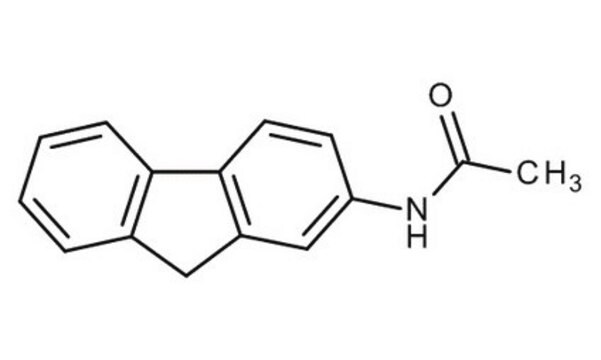A7015
N-(2-Fluorenyl)acetamide
≥98% (HPLC)
Sinonimo/i:
2-AAF, 2-Acetamidofluorene, N-Acetyl-2-aminofluorene
About This Item
Prodotti consigliati
Saggio
≥98% (HPLC)
Stato
powder
Punto di fusione
192-196 °C (lit.)
Stringa SMILE
CC(=O)Nc1ccc-2c(Cc3ccccc-23)c1
InChI
1S/C15H13NO/c1-10(17)16-13-6-7-15-12(9-13)8-11-4-2-3-5-14(11)15/h2-7,9H,8H2,1H3,(H,16,17)
CZIHNRWJTSTCEX-UHFFFAOYSA-N
Cerchi prodotti simili? Visita Guida al confronto tra prodotti
Applicazioni
Azioni biochim/fisiol
Avvertenze
Danger
Indicazioni di pericolo
Consigli di prudenza
Classi di pericolo
Acute Tox. 4 Oral - Carc. 1B
Codice della classe di stoccaggio
6.1C - Combustible acute toxic Cat.3 / toxic compounds or compounds which causing chronic effects
Classe di pericolosità dell'acqua (WGK)
WGK 3
Punto d’infiammabilità (°F)
Not applicable
Punto d’infiammabilità (°C)
Not applicable
Dispositivi di protezione individuale
Eyeshields, Gloves, type P2 (EN 143) respirator cartridges
Scegli una delle versioni più recenti:
Possiedi già questo prodotto?
I documenti relativi ai prodotti acquistati recentemente sono disponibili nell’Archivio dei documenti.
Articoli
DNA damage and repair mechanism is vital for maintaining DNA integrity. Damage to cellular DNA is involved in mutagenesis, the development of cancer among others.
Carcinogenesis and Epigenetics
Il team dei nostri ricercatori vanta grande esperienza in tutte le aree della ricerca quali Life Science, scienza dei materiali, sintesi chimica, cromatografia, discipline analitiche, ecc..
Contatta l'Assistenza Tecnica.





